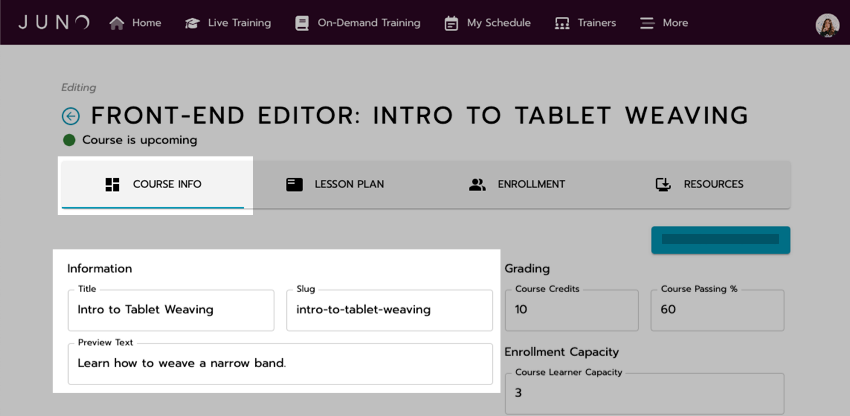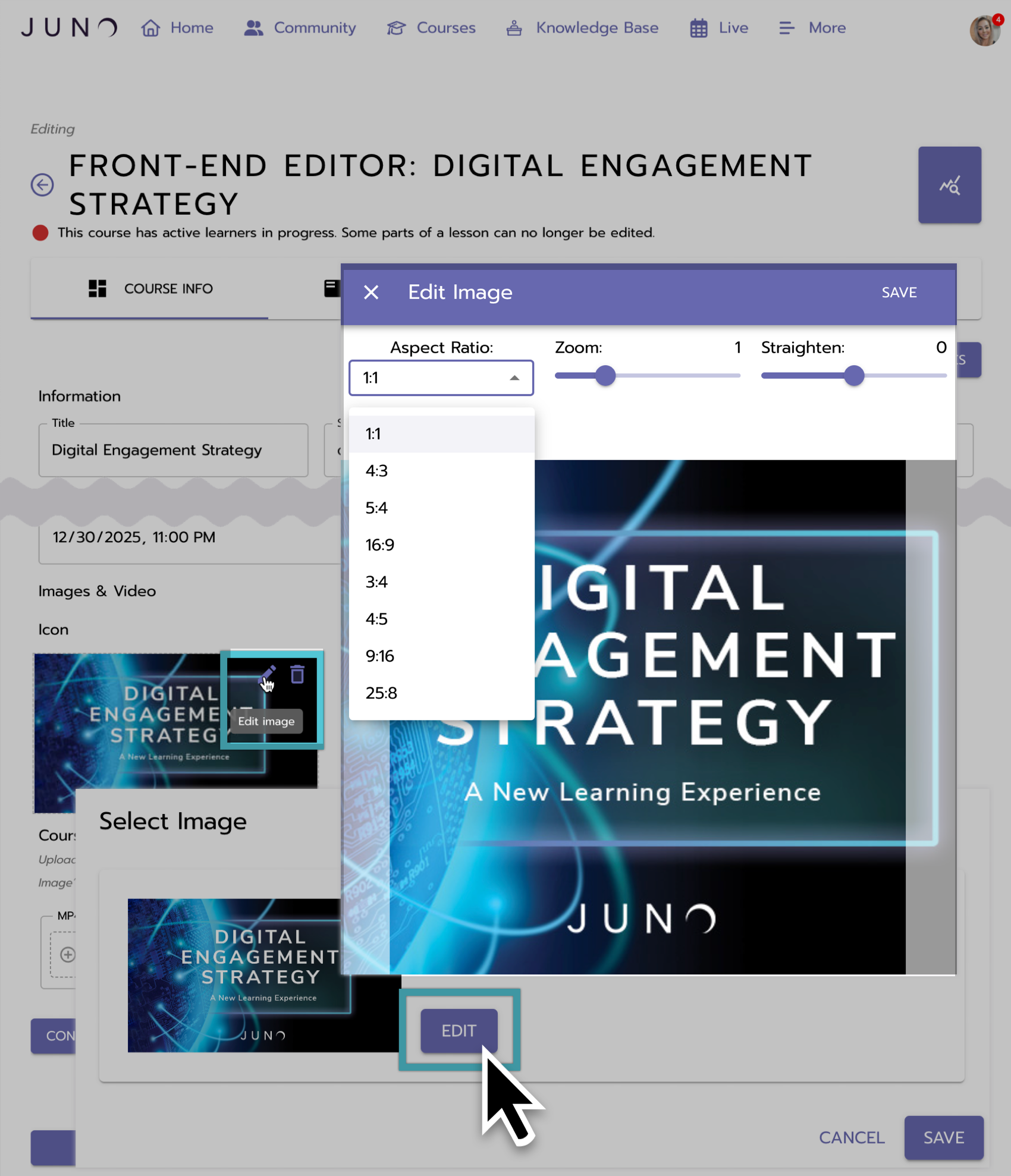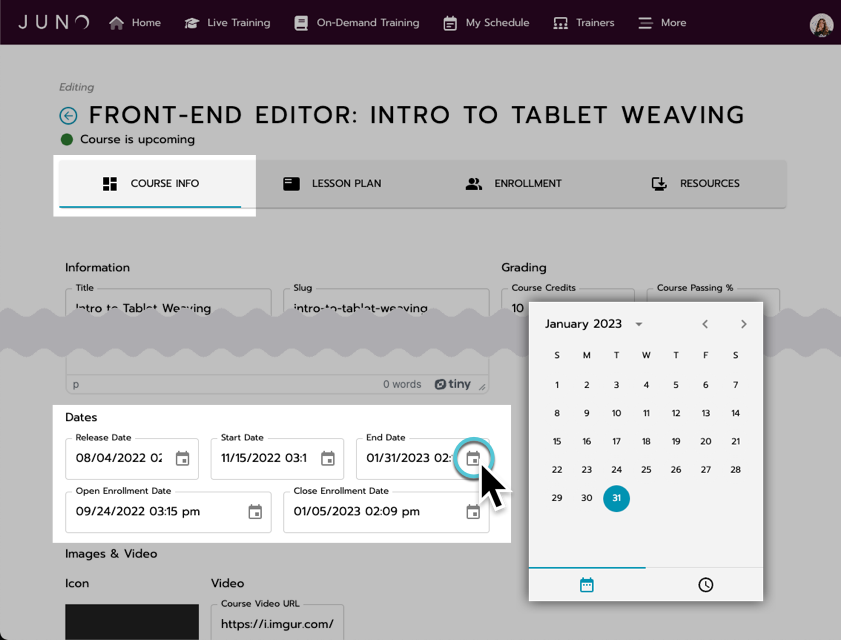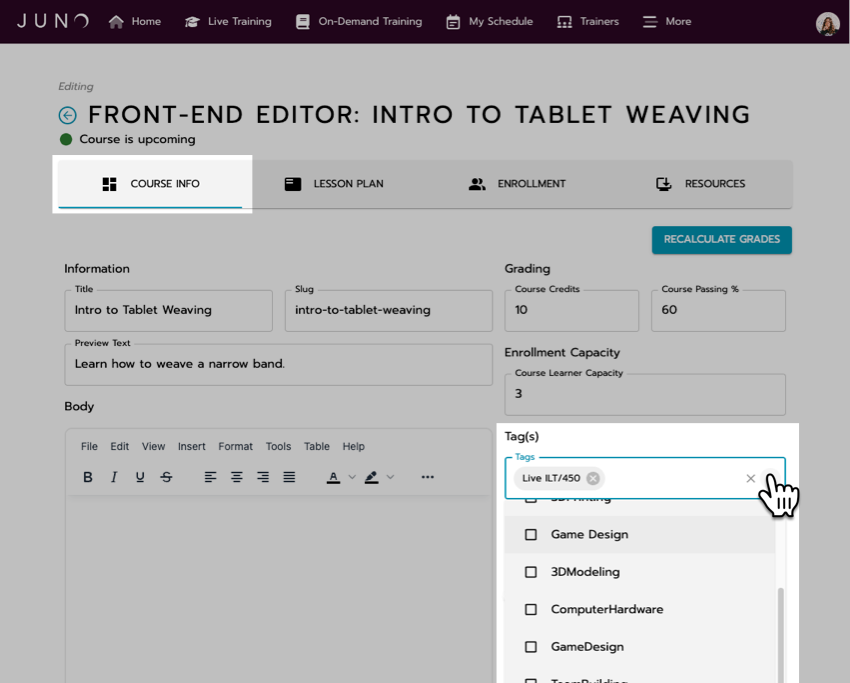Edit basic course information
This article is about the new JUNO learning management system (LMS). If you don’t see these features on your site, your platform still uses the legacy JUNO courses.
Begin setting up a course with the title, preview text, slug, dates, icon image, and tags.
Before you begin
Open the course editor to follow these instructions.
Remember to click Save at the top of the page before going to a different tab in the editor. Otherwise, you’ll lose your changes.
Who can edit this course information?
Add a title, slug, and preview text
In the Course Info tab, fill out these fields:
Title: Users see this before they open a course and on the course home page. 90 characters max. Special characters not recommended.
Preview text: 78 characters max. A short description of the content displayed in rotator, grid, or list modules.Users see it before they open a course. It doesn’t appear on the course home page once they open it.
Slug: This was created automatically when you created the course, but you can change it if you want. The slug is the end of the URL. Every slug must be unique. Note that spaces, special characters, and capital letters aren’t allowed. Use underscores
_instead of spaces.

Adding a title, slug, and preview text.
Add an icon image
Every course needs an Icon image. It displays in rotator, grid, or list modules on your site so that users see it before they open a course. It also displays at the top of the course home page before users start the course.
If you don’t add an icon image, a default gray image displays instead.

An example module with course titles, preview text, and icon images.
To upload an image:
Go to the bottom of the Course Info tab.
Select the Icon Square or Drag an Icon image into the Icon Square to upload an image.
Once an image has been input, an Edit, Cancel, or Save window is available.
Here, you can Edit how the image is reflected on the Catalog and Course Homepage.
Select Save.
Once saved, you can also go back in and edit the image further.
Image specifications and recommendations
Image size (w x h): 800 × 450 px
Small image file sizes help your site load faster. Follow these specifications:
Image file size: Below 200 KB unless otherwise specified.
Image file type: .jpg unless otherwise specified. This helps reduce the file size. If you need a transparent background, use .png.
Editing images: Original Images are not retained after editing, but you can discard and start again.

Uploading an Icon image.

Editing an Icon image.
Set dates
In the Course Info tab, set the following dates in your computer’s local time. You can type the date and time into each field, or use the date selector:
Select the Calendar icon, then select a day, hour (AM or PM), and minute. Do not click away before selecting all three, or your changes won’t save.
Release Date: When the course becomes available and visible to users on the site. They can open the course home page, but can’t necessarily start taking the course yet. Must be after the start date.
Open Enrollment Date: When users can begin enrolling in the course. Must be after the release date.
Close Enrollment Date:When users can no longer enroll in the course. Must be after the open enrollment date.
Start Date: When users can start the course. Must be before the end date.
End Date: When the course closes and users can no longer take it. Must be after the start date.
Once you set a release date, all other dates become required in order to save your changes. If you aren’t ready to set the other dates yet, set it up without a release date, and save it to work on later.
See Edit course enrollment settings to understand all enrollment settings.

Selecting course dates.
Add tags
Tags are used to group content into different modules around your site. Learn more about all tags.
In the Course Info tab, select one or more tags to add them to the course. You can select from the dropdown list or type to search.
Remove a tag by selecting X next to it.
At this time, you can only select from tags created in the new JUNO LMS. This is because we are building the new LMS on an upgraded database. Those tags are not synced with the rest of your existing database, which causes some limitations. For example:
You can’t recommend courses based on user interest tags from the existing database.
You can’t pull courses from the new LMS into modules on any page (like your home page). Instead, you can only pull them into course catalog pages created specifically for the new LMS.

Adding tags to a course.
Related articles
- Edit course resources
- User types and permissions for learning management
- Edit course grading settings
- Education credits and course information pages
- Why does lesson editing lock?
- Creating or importing learning packaged courses
- Edit the course home page
- Attaching an access pass to an education credit
- Creating Education Credits (EC) in Das Admin
- Content Certificates
- Add instructors to a course
- Edit course lessons
- Attaching a certificate to an education credit
- Edit basic course information
- Edit course enrollment settings
